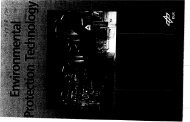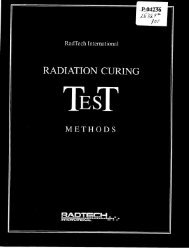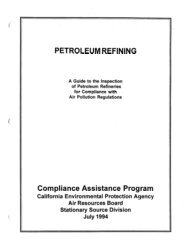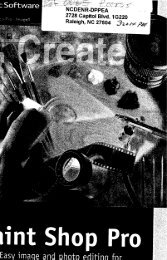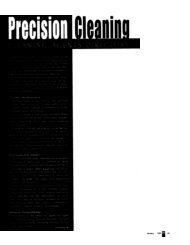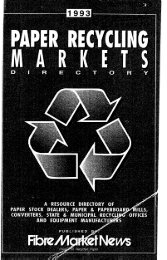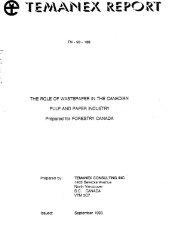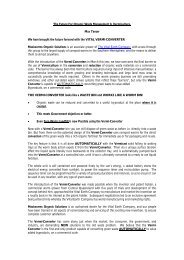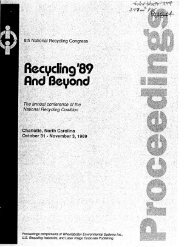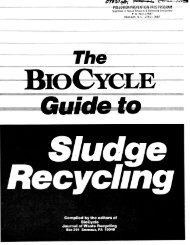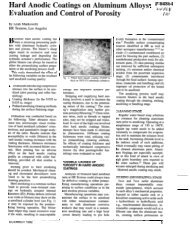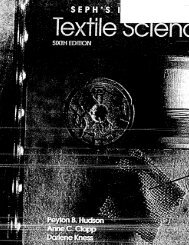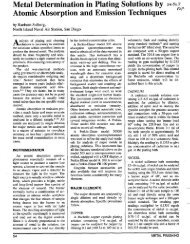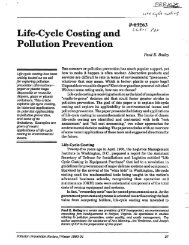Electronic Parts/Guidelines - infoHouse
Electronic Parts/Guidelines - infoHouse
Electronic Parts/Guidelines - infoHouse
You also want an ePaper? Increase the reach of your titles
YUMPU automatically turns print PDFs into web optimized ePapers that Google loves.
Plastic Container Manufacturing: The above plastics are some of the more commonly used plastics for<br />
reusable containers. in many applications, these materials can be designed and manufactured into<br />
very rugged and durable containers. Although this guide does give general descriptions of manufac-<br />
turino techniques, the package designer should work with plastic container suppliers to identify and<br />
select the most environmentally-sound, cost effective and durable container design and manufacturing<br />
technique. The following are general descriptions of some of the more common manufacturing tech-<br />
niques:<br />
Injection molding: This is the most common method or process for manufacturing plastic con-<br />
tainers. It provides design flexibility and can produce fine details and uniform wall thickness's<br />
Injection molding tooling is often very expensive. A variation of injection molding, structural foam<br />
molding, requires less expensive tooling. The process involves blowing nitrogen gas through<br />
plastic In a mold. This produces a container wall that has bubbles or voids, but still very stiff. This<br />
technique offers stiffness with less material.<br />
Rotational molding: In this process, liquid (melted) plastic is formed into a container within a<br />
female mold, while the mold is rotated around two axes and heat is applied. Rotational molding is<br />
often used for larger containers that require lots of material. Tooling is moderately to very ekpen-<br />
slve.<br />
Vacuum forming. There are three types of vacuum forming: straight, pressure molding and stretch<br />
forming. Vacuum forming is generally used for containers that have simple configurations and for<br />
lower container volumes (number of units), where higher priced tooling and techniques can not be<br />
justified. Vacuum forming is also generally limited to smaller containers and containers where<br />
dimensional tolerance and consistency is not critical. Tooling for vacuum forming is relatively<br />
inexpensive.<br />
Blow molding. This process is used to form bottles or containers from plastic by expanding a<br />
blank in a hollow mold. The blank is ordinarily a tube. The molds for this process are generally<br />
inexpensive. The most common application of this process is the manufacture of cases for tools.<br />
High Density Cushions: To provide durability and adequate shock protection over a long reuse life,<br />
reusable cushions are usually made of high density foams. The most common high density foam<br />
material used is expanded-polyethylene. Densities of 32 kPa (4 Ibs/cubic R) or greater are often used.<br />
This materlal can be molded and hand or machine fabricated. It is also commonly available and<br />
recyclable. Other high density foams sometimes used are polypropylenes and some polyurethanes.<br />
Corrugated Fiberboards: One of the biggest concerns with reusing Corrugated flberboard containers is<br />
with top-to-bottom compression strength. The compression strength, after repeated uses and exposure<br />
to changing temperature and humidity conditions, quickly weakens. A few alternatives to maintaining<br />
or increasing compression strength include:<br />
adding more flber thru thicker linerboards and mediums or by using a multi-wall construction (Le.,<br />
double or triple wall) ... this adds to material cost and increases the container weight and size,<br />
adding to transportation costs:<br />
using cross-linked fibers ... this paper production technique redirects some wood fibers to run 90<br />
degrees to the paper's machine direction, resulting in more fibers running vertically up and down<br />
on the linerboard of containers;<br />
using high-pressure forming ... this paper production technique involves extending the point of pres-<br />
sure on paper fibers. to more tightly compress them, resulting in a denser sheet of material:<br />
using multiple or bonded mediums ... this paper making technique is based on laminating (usually<br />
with corn-starch adhesives) two or more layers of medium together and then sandwiching the<br />
material between cross-linked or pressure formed liner boards; and<br />
using chemically treated fibers ... this paper making process involves the bonding of fibers with corn<br />
starch, glues, adhesives, PCB's, heavy-metals, and plastic or urea-formaldehyde resins: the use of



